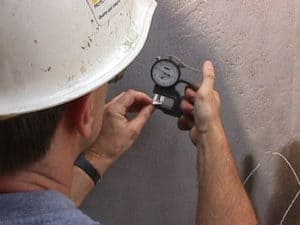KTA’s Certified Coating Inspector Forum Issue No. 2 – June 2022
KTA’s Certified Coating Inspector Forum is designed to provide continuing education on standards, inspection practices, new instruments, and other topics to help keep certified AMPP and FROSIO coating inspectors current. It is occasionally written blog style, and represents the views of the author and KTA-Tator, Inc. It may or may not represent the views of AMPP: The Association for Materials Protection & Performance, even though SSPC, NACE, and AMPP standards are frequently referenced in the content.
As trained and certified coating inspectors, we rely heavily on instruments to take measurements to assess conformance to specification and coating manufacturer requirements for surface profile, ambient conditions, surface soluble salt detection, coating hardness, coating thickness, wall thickness, etc. The accuracy of the instruments used to take these types of measurements is paramount to obtaining reliable data, so most instrument manufacturers recommend annual calibration of the gages. AMPP Qualification Procedure (QP) programs for contractors and inspectors (e.g., legacy SSPC Painting Contractor Certification Programs like QP1) require that instrumentation used to obtain measurements to determine conformance to a governing specification be calibrated and that the instruments are also verified for accuracy prior to use. According to AMPP Ethics Training1 the use of uncalibrated instruments to obtain measurements to determine conformance to governing coating specifications is considered a malpractice ethics violation.



This Inspector Forum explains calibration and contains a reference table listing many of the instruments that are used to verify the quality of surface preparation and coating installation work, along with the frequency in which calibration should be performed. It also provides direction on how to verify accuracy (when feasible) and assess functionality prior to use.

Calibration is a high-level, controlled, documented process (performed by the gage manufacturer or an accredited calibration laboratory) of obtaining measurements on traceable standards over the full operating range of the gage, then making the necessary repairs to correct any out-of-tolerance conditions. Calibration is performed in a controlled environment that is not typically found on a project site.

Verification of accuracy is performed by the gage/instrument operator and does not need to be performed in a controlled environment. One ASTM standard2 defines verification of accuracy as, “obtaining measurements on coating thickness standards, comprised of at least one thickness value close to the expected coating thickness, prior to gage use for the purpose of determining the ability of the coating thickness gage to produce thickness results within the gage manufacturer’s stated accuracy.”

Based on the accuracy verification process, subsequent adjustment to the instrument may be necessary to compensate for actual shop or field conditions.


The table that follows lists some common coating inspection instruments and the corresponding frequency of calibration and verification of accuracy intervals. It also provides direction on ways to verify proper functionality prior to use.
| Instrument | Calibration Frequency | Accuracy Verification (Frequency and Method); Functionality Check |
| Whirling (sling) psychrometer | Annual3 | Prior to each period of use (visual check for separated fluid, wick position & cleanliness). See footnote 3 for ways to verify accuracy. |
| Dial-type surface temperature thermometer | Annual2 | Prior to each period of use (visual check for bent bi-metallic spring, abrasive lodged in spring, or fogged/broken glass). See footnote 3 for ways to verify accuracy. |
| Thermocouple-type surface temperature thermometer | Annual2 | Prior to each period of use for damaged thermocouple end and/or paint on thermocouple. Accuracy cannot be verified in the shop or field |
| Paint thermometer | Annual2 | Prior to each period of use (visual check for fogged/broken glass), See footnote 3 for ways to verify accuracy. |
| Digital psychrometer | Annual2 | Prior to each period of use for damaged thermocouple end and/or paint on thermocouple; battery life. Accuracy cannot be verified in the shop or field. |
| Non-contact infrared Pyrometer | Annual2 | Prior to each period of use (visual check for clean lens); battery life. Accuracy cannot be verified in the shop or field. |
| Surface profile depth micrometer | Annual2 | Prior to each period of use (zero on glass plate and verify accurate readings on measured metal shim). Battery life. |
| Spring micrometer (used w/ replica tape) | Annual2 | Verify zero-set with anvils closed prior to each period of use. Can use a certified metal shim to verify accuracy of readings if required |
| Wet Film Thickness Gage | Annual2, 4 | Prior to each period of use for presence of dried paint or evidence of adulteration (e.g., filing) Accuracy cannot be verified in the shop or field |
| Certified Thickness Standards | See Footnote 5 | See Footnote 5 |
| Certified Thickness Shims | See Footnote 6 | Prior to each use with micrometer6 |
| Type 1 (magnetic pull-off) dry film thickness gage | Annual2 | Prior to and after each period of use (certified coated standards) |
| Type 2 (electronic) dry film thickness gage | Annual2 | Prior to and after each period of use (certified coated standards). Battery life. |
| Tensile Pull-off Adhesion Tester | Annual2 | Accuracy cannot be verified in the shop or field |
| Low voltage (sponge) pinhole detector | Annual2 | Accuracy cannot be verified in the shop or field. Check continuity from wetted sponge to ground wire attachment location. Battery life. |
| High voltage holiday detector | Annual2 | Accuracy can be verified prior to each period of use using a peak voltmeter. Battery charge. |
| Moisture meters | Annual2 | Prior to each use (per manufacturer recommendations – check plate/box, internal button, or other method). Battery life. |
| Ultrasonic wall thickness gages | Annual2 | Prior to each period of use (step blocks). Battery life. |
| Durometer hardness | Annual2 | Prior to each period of use (hardness block). If electronic, battery life. |
| Light Meter | Annual2, 7 | Cleanliness of sensor. Accuracy cannot be verified in the shop or field other than to verify the meter reads 0 when the cap is on. Battery life. |
| Tape Measure | See Footnote 8 | See Footnote 8 |

3 Tube thermometers: Certificates of accuracy are provided with most tube thermometers and accuracy can be verified in the shop/field by placing a traceable thermometer next to the tube thermometers (covered to protect them from drafts/air flow) and permitted to stabilize for a minimum of 30 minutes. Dial-type surface temperature thermometers and stem-type paint thermometers can also be verified for accuracy using this method. The readings are compared to the traceable thermometer. Note that this procedure is only valid for one temperature point (that of the traceable thermometer) unless a variable temperature chamber is used. Good practice would be to make the comparisons every few weeks.
4 Wet Film Thickness (WFT) gage: A Certificate of Calibration is provided with one manufacturer’s notch-type WFT gage (e.g., KTA WFT Gage); however, the gage cannot be recertified. Annual replacement is recommended for the KTA WFT Gage. Also, the accuracy of the gage cannot be verified in the shop/field.
5Certified coated thickness standards: A Certificate of Calibration is provided when the standards are purchased new. The only way to verify they remain in tolerance over time is to measure them with a calibrated dry film thickness gage and determine whether the readings are within the combined tolerance of the gage and standards (sum the squared tolerance of the gage and standards, then calculate the square root). For example, if the tolerance of the gage is 3% and the tolerance of the standards is 5%, the combined tolerance is 6%. If the calibrated dry film thickness gage reads 9.4-10.6 mils on a 10-mil coated standard, the gage/coated standard combination is considered accurate. But note that the specific reason for the readings at the low or high end of the acceptable range cannot be attributed to the gage, to the standard, or to a combination of both.
6Certified shims: A Certificate of Calibration is provided when the shims are purchased new. The thickness can be verified with a calibrated spring micrometer, provided the load on the anvils of the micrometer does not damage thinner shims (i.e., shims less than 5 mils).
7Light meter: Most light meters that are used to assess the amount of ambient light (natural and/or man-made) in a space come with a manufacturer’s Certificate of Accuracy. However, there are no common practices for verifying accuracy in the shop or field.
8Tape measure: At least one manufacturer (Starrett) provides a Certificate of Calibration with their tape measures. Verification of accuracy can be performed using a secondary standard, such as a piece of angle iron bolted to a wall and the length of the angle iron sighted-in using a precision laser. Alternatively, a tape measure with a Certificate of Calibration may be designated solely for verifying the accuracy of other tape measures and stored/secured to prevent any other use.
Summary
Instruments that are used to verify quality must be calibrated and verified for accuracy, when feasible. Instrumentation is calibrated by the equipment manufacturer or an accredited calibration laboratory, while the instrument user is responsible for verifying accuracy. Many of the instruments used to verify the quality of surface preparation and coating application can be calibrated and verified for accuracy; several can be adjusted by the user as needed when verifying accuracy. But for some instruments, the user cannot verify accuracy. For those instruments, the user should at least verify cleanliness, look for obvious damage or defects, and if electronic, confirm battery life. Confidence in any data set is realized only when the measurements are obtained using instrumentation that is maintained within the manufacturer’s stated tolerance. Additionally, the functionality of an instrument should be verified prior to each use, when applicable.




